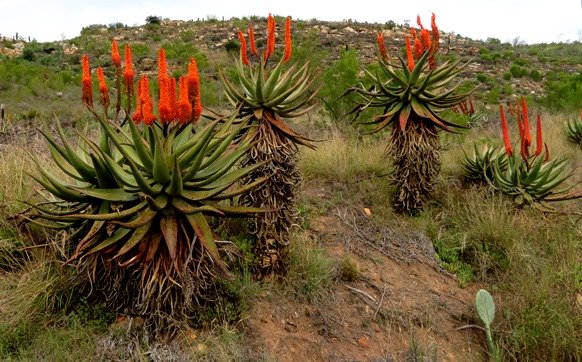Aloe ferox

Author: Ivan Lätti
Photographer: Thabo Maphisa
These Aloe ferox plants on the north-facing slope between Louterwater and Krakeel were well into blooming by May. Only a few flowers of each raceme open simultaneously, with buds above and withered flowers below. The ring of open flowers begins at the raceme base, moving up to the last flowers to open at the top weeks later. This is a feature of all Aloe blooming.
The flowers are self-sterile, meaning that they require pollen from other flowers of their species to fruit. The stamens of the open flower produce pollen in the morning and wither in the afternoon. The style of the open flower is exserted only on the next day for hungry birds and bees to do their thing.
When left undisturbed, the stems retain their dry leaves to near ground level, also on old, tall plants. Only the lowest live leaves sag their tips towards the ground, usually without curving down, although some specimens may display slight downward curving of especially their lowermost green leaves.
A pale, elliptic leaf of a prickly pear, an exotic of the Opuntia genus and cactus family is prominent in the foreground. Far back on the horizon more of the same aloes grow among the rocks and grassy scrub.
Moving further south on this southerly, Peak Formosa side of the Langkloof the veld soon becomes fynbos, well before reaching the Tsitsikamma Mountains.
Tsitsikamma, the place of much water, a name retained from the Khoi language, has an annual rainfall in excess of 1000 mm. This sustains verdant fynbos and famous high forest to the south of the mountain range and down to the sea (Van Wyk and Smith, 2017; iNaturalist; http://www.llifle.com).

